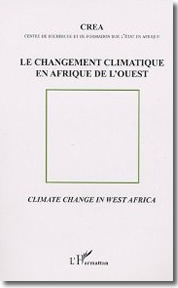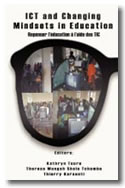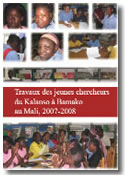Climate Change in West Africa / Le changement climatique en Afrique de l’Ouest May 13, 2010
edited by Massimiliano Mondelli and published by Harmattan, 2009, reviewed by Kathryn Toure in 2010
This small 125-page collection of papers in French and English is a primer for understanding the impact of climate change in West Africa and the need for regional strategies and solidarities to complement the National Adaptation Programmes of Action (NAPAs). The papers were presented at a colloquium in Cote d’Ivoire on how to increase the capacity of West African states to deal with climate change.
The papers indicate how village people and scientists agree that a change in West African climates started about 30 years ago with decreasing rains, especially in the 1970s and 1980s. In addition, today, rising sea levels threaten coastal communities from Douala to Dakar– where 40% of West Africans live.
Africans are adapting to climate variability and change, brought about in part by over consumption of energy and other resources in other parts of the world. Diversifying livelihoods is one way of adapting. Pastoralists, who find less grassland for their cattle and other livestock, have begun planting and harvesting crops. Farmers diversify their activities as well, for example by undertaking work in town. Employing agricultural innovations such as soil conservation and water management techniques is another way of adapting. For example, to survive on arid land in Burkina Faso some farmers use a technique called “zaï” (p. 88) which involves digging a hole and putting organic material along with the seed into it. This helps capture rainwater, fertilize the plant, and limit erosion.
Rural people and scientists are working together across the continent to understand and inventory the multiple ways in which people are creatively and innovatively applying local knowledge to adapt to climate variability and change. Because the pace of change is so frenetic, the contribution of scientists is important to help improve innovations and to inform efforts to extend the use of successful approaches. Combining knowledge from seasonal climate forecasts and local indigenous climate forecasts, for example, helps farmers decide which crops to plant, i.e. sorghum and millet during dry periods, cow pea when conditions are between dry and wet, and manioc and beans for very wet conditions (pp. 72-73). Further developing such strategies to deal with climate variability could help in adapting to more dramatic climate changes.
What approaches are States considering? They are beginning to explore proactive strategies such as national grain reserves, support to research, including scholarships for young researchers, and better coordination within and between States, for example when it comes to water management. While West Africa as a whole may not face renewable water shortages, local challenges may emerge (p. 65). What is needed is a more integrated regional approach. The protection of forests in Central Africa is important in reducing carbon dioxide emissions that contribute to rising world temperatures, melting of glaciers, rising sea waters and climate changes. Global investments as well are needed in this area. Another challenge is providing incentives and alternatives for households and communities to move away from wood and charcoal for cooking, because of the greenhouse gases the burning process releases into the environment.
Authors of the various papers stress the need for information, education and communication to sensitive people and “give them” weather information (p. 92) and adaptation strategies. What is missing in this primer is more in depth discussion of the value of more bottom-up and horizontal approaches such as participatory action research (see www.idrc.ca/ccaa), in which farmers, working iteratively with researchers and elected officials and government employees, help gather and interpret the information they need.
Enrico Porceddu, moving into more philosophical and metaphysical dimensions, reminds us that “land has a larger and more pregnant meaning than geographical area. Land presupposes a space, but it is the environment where individuals want to develop their projects…. Land is the place where they integrate their forces and intents” (p. 76). We are one with the land, and if humans are to continue to inhabit the planet earth, we must live in harmony with land and transition from dependency on gas and oil to renewable energies that rely on hydro and solar power and on wind and other natural processes.
I recommend this quick read to all those who would like to understand the effect of climate change on agriculture, health, economic development and other sectors and explore the opportunities that climate change presents to revisit and reorganize the way we interact with each other and our environment.
[ Download ]



Leave a Reply